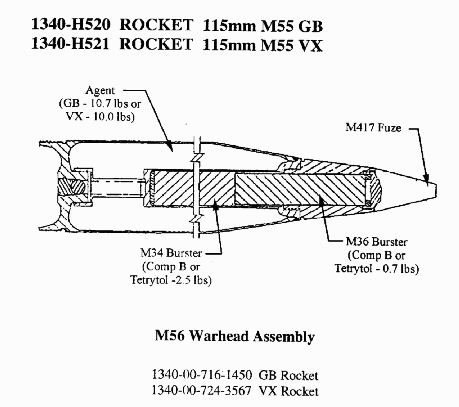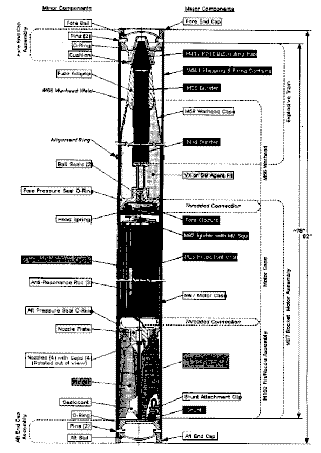




The M55 Rocket was produced in the late 1950s to provide toxic chemical offensive capability for large target areas at long range. The rocket was designed for battlefield use, and consisted of an aluminum nozzle assembly with spring loaded fins, a rocket motor, and a fused warhead containing chemical agent. Designed to carry approximately 10 pounds of agent, the rockets are 83 inches tall, and are packed in a cylindrical fiberglass shipping and firing tube. The M55 rockets can also be recognized by three green bands around the body.
The M55 rocket consists of a chemical agent filled warhead attached to a rocket motor. It has a diameter of 115 millimeters (4.44 inches), is 78 inches long and weighs 57 pounds. The warhead is filled with either 10.7 pounds of GB or 10.0 pounds of VX. The rocket is stored in a shipping and firing tube. The tube is made of fiberglass reinforced resin, either expoxy or polyester. The warhead consists of a body, a burster well containing two bursters in series, a fuse adapater, and a point detonating fuse. The rocket motor consists of a body, nozzle-fin assembly, propellant, igniter assembly, and end cap. The propellant is an M28 double base [nitroglycerin and nitrocellulose] cast grain weighing 19.3 pounds. The rockets are stored with 15 rounds per pallet assembly secured with metal banding.During the early 1960s, the U.S. Army stored M55 rockets at Black Hills Army Depot, South Dakota. Simulant rockets containing water or ethyl glycol instead of chemical agent were used to train soldiers on the proper handling and firing of the M55. Some of the explosive simulant rockets were used in storage igloo explosion tests, and the remains of some of those rockets were not recovered.
Other sites where the M55 rockets were formerly stored are Rocky Mountain Arsenal, Colorado and Okinawa, Japan. From Japan, they were later moved to Johnston Atoll in the Pacific. The rockets were briefly tested at Aberdeen Proving Ground, Maryland, and they were originally produced at Newport Army Ammunition Plant, Indiana. However, neither of these locations stored them for extended periods of time.
The U.S. chemical stockpile sites that still store the M55 rockets are Anniston Army Depot, Alabama, Blue Grass Army Depot, Kentucky, and Umatilla Army Depot, Oregon. M55 rockets are currently stored at Tooele Army Depot, Utah and are scheduled to be disposed in the near future.
Congress has mandated a deadline of December 31, 2004, for disposal of the U.S. chemical weapons stockpile. On January 23, 1995, the Army released a report to the public on the remaining storage life of the M55 rockets in the U.S. chemical weapons stockpile. As part of the Chemical Stockpile Disposal Program, the Army has performed several hazard analyses and risk assessments of continued storage of chemical munitions, including this recent study on M55 rocket propellant stability. These studies were conducted to determine if degradation of munitions and their contents could contribute to an increased risk to the public. The results indicate that the rockets can be safely stored until they are required to be disposed of by the congressionally-mandated deadline. The M55 Rocket Storage Life Evaluation report focused on the rate of deterioration of the propellant found in the approximately 478,000 M55 rockets in the U.S. stockpile. These rockets - containing chemical agent fill, explosives, and propellant - are stored in five locations throughout the United States and at Johnston Island in the Pacific. Those five other locations are: Tooele, Utah; Anniston, Alabama; Umatilla, Oregon; Pine Bluff, Arkansas; and Blue Grass, Kentucky. As of March 1997, all rockets at Johnston Island have been safely destroyed. Previous reports predicted the possibility of autoignition, caused by the natural depletion of the propellant stabilizer ranging from 27 to 100 years from the date of manufacture. The stabilizer is a substance that was added to the propellant to slow its degradation. Technical experts, including the manufacturer of the propellant, used two different methods to estimate the storage life of non-leaking M55 rockets. The most conservative model, one proposed by the propellant manufacturer, estimated that there is less than a one-in-a-million chance that a rocket will ignite by itself before the year 2013. The report cautioned that its conclusions are limited only to non-leaking rockets. There is some evidence that internally leaking rockets in which the propellant came in direct contact with chemical agent could have shorter storage lives. The report noted that additional data should be obtained to gain more confidence in the estimate because the samples which were studied may not represent the condition of rockets at all storage locations. An investigation is under way to find whether propellant exposure to chemical agent increases the rate of deterioration of the stabilizer itself. The Army is currently addressing these issues as part of its Enhanced Stockpile Surveillance Program and will release a new report upon completion of this assessment.

